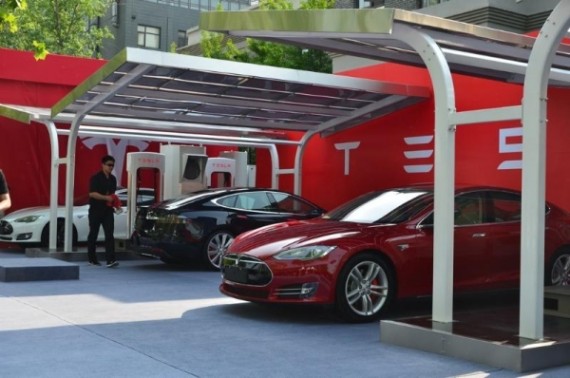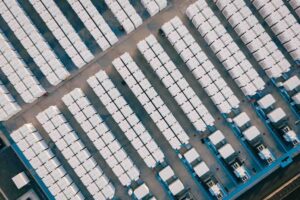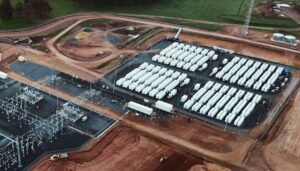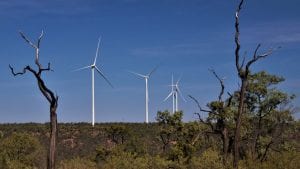Tesla Motors, the electric vehicle company throwing down a major challenge to the global motor industry, says it is now looking to become a front-runner in energy storage in a major new challenge to the traditional electric utility business model.
Tesla, which already has a market worth more than half of General Motors, despite having just a fraction of the sales, says its next big market is the battery storage sector, and will release a lithium-ion battery storage produce in the next few months.
Chief technical officer JB Straubel says designs are nearly complete, and production will begin within the next six months.
“We’re going to unveil some of the Tesla home battery consumer battery that will be for you using and people’s houses or businesses, fairly soon,” he told an analysts in a conference to discuss Tesla’s latest results. “It’s really great. I’m really excited about it.”
Tesla, with its Model S vehicle, has broken down the barriers on electric vehicles with its high performance, luxury and extended range (400kms to 500kms), and its success has accelerated the EV efforts of other car makers such as BMW, GM and Ford.
Its $5 billion giga-factory, the first large-scale motor vehicle battery plant in the world, is now being built in Nevada with the help of Panasonic. It is also expected to have a dramatic effect on the energy storage market, helping bring battery costs down by as much as two-thirds, according to some analysts.
But Tesla on Thursday also indicated it was planning to enter the consumer battery storage market with it own product. It has already tested the market in partnership with Solar City, the solar leasing company that is also chaired by Tesla founder Elon Musk.
The combination of rooftop solar and battery storage is expected to revolutionise the global utility business. However, while EV batteries can provide back-up to homes, and can export back into the grid, they are not as efficient for that purpose as specifically designed stationary storage arrays – in homes, business, or located on the grid.
Morgan Stanley said last year that Tesla’s energy-storage product could be “disruptive” in the US, Europe and other markets, encouraging consumers to go off-grid, helping to push battery storage costs below $100/kWh.
Other financial analysts from UBS, Deutsche Bank, and Citigroup, among others, have made similar conclusions, suggesting that the combination of solar and storage would be more cheaper than grid power within a few years in many countries, including the US and Australia. Citigroup says the advent of storage will hasten the demise of fossil fuels, centralised coal generators in particular.
The Tesla move directly into the consumer storage market could accelerate that impact. Already, utilities are starting to reshape their business to fit in with a new market that will focus on distributed, or local generation, rather than the centralized model that has prevailed for decades. In Australia, the major retailers, and numerous smaller players, are also rolling out solar plus storage offerings.
Bloomberg notes that Tesla has already installed a storage unit at its Tejon Ranch Supercharger station in Southern California and has several other commercial installations in the field.
 But Straubel (pictured right) also noted that the utility market may be even bigger than the consumer market, and said the company was talking to “almost all of them.”
But Straubel (pictured right) also noted that the utility market may be even bigger than the consumer market, and said the company was talking to “almost all of them.”
In California and Texas, there are large programs designed to encourage battery storage, which is seen as helping stabilize the grid, and allowing more variable renewable energy generation such as wind and solar.
It is also seen as a cheaper alternative to expanding and upgrading the poles and wires network, In Australia, Queensland network operator Ergon Energy is installing up to one hundred 100kWh battery storage units because it is less costly than traditional grid upgrades. The units will be installed without subsidies, and other network operators are also trialling various battery storage models.
Straubel has talked of his interest in battery storage before. He said last year that 400 kilowatt-hour battery pack at the Tejon Ranch supercharger site in Southern California “is the perfect application for energy storage” with its “incredibly peaky load,” he added.
Stationary applications are much easier to design for from a vibration, thermal and charge profile standpoint compared to an automobile. “The [energy storage] market is going to grow faster than people think,” although “the value of backup power is hard to quantify,” he said at the time.
Among other highlights from the conference call, Tesla said:
It had met its target of producing 35,000 vehicles in 2014 and plans to produce 55,000 vehicles in 2015.
Its Supercharger network now covers the US from coast to coast, as well as most of Europe.
The Model X falcon-wing minivan is slated to begin shipping in six months. It has 20,000 reservations.
Musk said that if the company could keep at current growth rates, it would be worth as much as Apple is today ($US700 billion) within 10 years.
To do that, Tesla plans some significant capital expenditure, of a scale that is rarely seen in modern companies today.
“We are going to spend staggering amounts of money on CapEx,” Straubel said. “I mean for a good reason and with the great ROI (return on investment).
The Gigafactory began construction two months ago, and its battery pack (for cars) will be in mass production in 2016.











